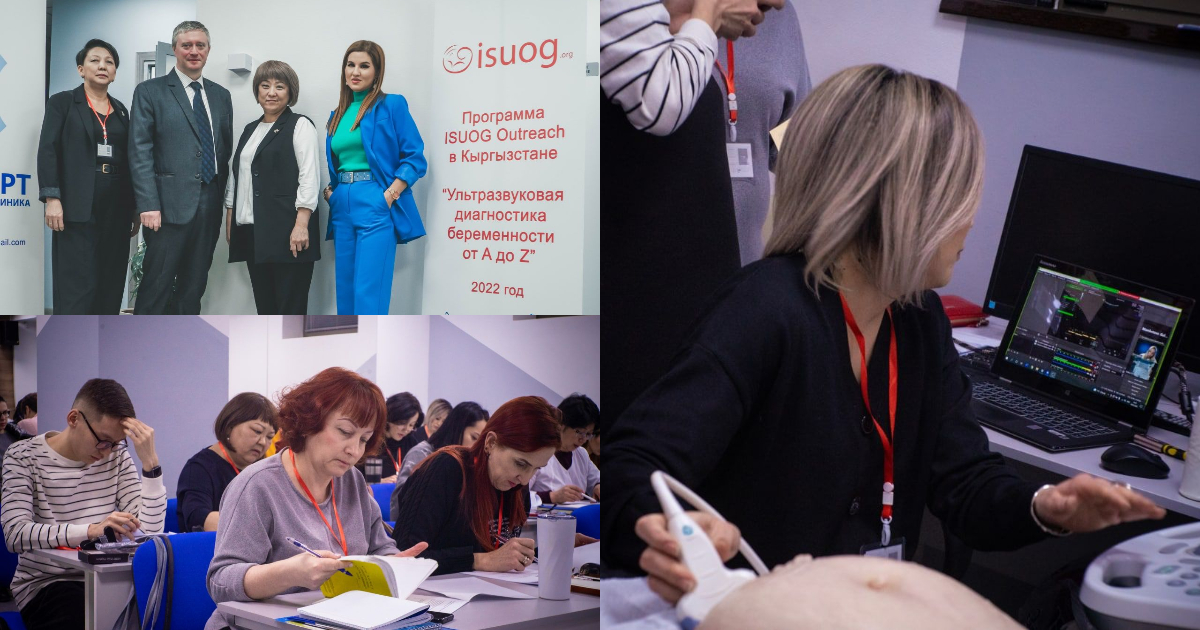ISUOG Outreach training in ultrasound in obstetrics and gynecology in Kyrgyzstan - Phase I Trip 1.
Location: Bishkek, Kyrgyzstan (managed by ISUOG virtually, conducted on the ground locally with trainers coming in virtually from Russia, Ukraine, and Belarus)
Dates: 10-14 January 2022
Project Partners: Kyrgyz Association of Radiology, the Kyrgyz Ministry of Health and Scanbooster for this program.

ISUOG Training Team:
Dr Irinia Tihonenko (Belarus)- Leader
Dr Elena Andreeva (Russia)
Dr Elena Susidko (Ukraine)
Dr Elena Nekrasova (Russia)
Project Advisor for Virtual Training were Dr Titia Cohen-Overbeek (The Netherlands) and Dr Divya Singh (India)
Trainees: 25
Project Purpose: To provide ultrasound training to local OB/GYN practitioners in Kyrgyzstan with the intention that these trainees eventually become local trainers and build local capacity for greater sustainable development in maternal health outcomes countrywide.
Project Deliverables
Goal: By the end of Phase I, local trainers will be confident in scanning techniques and conduct quality scans in line with basic training outreach templates (SO2).
Output: Training local trainers in basic ultrasound in OB/GYN scanning by evaluating their progress and provide mentoring between programs.
Outcome: Trainers will be confident in quality OBGYN scanning and competent in delivering OB/GN ultrasound training to help increase the level of anomaly identification and aid in preventing preventable causes of maternal mortality locally.
Participants: 25 trainees from across Kyrgyzstan
Training Location: Bishkek Training Centre
This was the second fully virtual program conducted by ISUOG Outreach in response to travel restrictions caused by the COVID-19 pandemic. All trainers and ISUOG Outreach team utilised Zoom in order to carry out theoretical and practical training, including assessments.
Due to difficulty in assuring practical training, greater preparation was done in order to assure this aspect when as smoothly as possible. One of the key issues was ensuring guiding in hand coordination for scanning without the presence of the trainer. To solve this problem, ISUOG Outreach organised with the Kyrgyz Association Trainee Assistants who served as a help to the Virtual ISUOG Trainer on the ground. The requirements for the Trainee Assistant were to be able to have experience already in ultrasound scanning and also submit images in order to assess skill. This protocol was developed and helped under the guidance of Dr Titia and Dr Divya who participated in the first virtual Outreach program in Oman and offered their experience to guide the Kyrgyzstan Outreach Team.
In addition, to help the trainees with their learning, ISUOG Outreach partnered with German technological firm Scanbooster to provide free licenses of their ultrasound scanning practice app to the trainees.
During the practical session, Zoom was installed within the ultrasound machine and another phone was used in order to provide a view of both the ultrasound screen as well as both the hand coordination of the trainee and the keyboard.
The Basic Training Curriculum was used in training and divided accordingly among the trainees for delivery, with pre- and post-test assessment in both practical and theoretical skill set applied at the beginning and end of the program in order to assess skills attained. The entire training took place in Russian with a special English-Russian translation app used by non-Russian speakers (such as the ISUOG Team and the Project Advisors) in order to communicate with the trainees and some trainers.
Ultrasound machines were varied in brand and provided by neighbouring hospitals in Bishkek for the duration of the training. All machines were operating and serviceable.
Trainees were divided into groups of six to five with each trainer subsequently becoming their mentor accordingly. Trainees will now send images on a weekly basis to their trainers with quarterly targets for cases to provide before the next training session which will hopefully be on the ground in Bishkek. Instead of WhatsApp, the team is using Telegram instead.
The first impression was one of complete amazement at the effort in which both the Kyrgyz Ministry of Health and the Kyrgyz Association of Radiology put into the project in order for it to run smoothly. During the initial site visit, the internet was both extremely weak which put into doubt the possibility of success. But with the investment from the Kyrgyz government in providing a stronger internet grid and the actions taken by the Kyrgyz Association of Radiology in order to respond to ISUOG Outreach’s needs, both trainers and trainees were impressed with the overall efficiency and almost flawless execution of the program.SUOG Outreach would like to seriously thank its partners, its team and the stakeholders on the ground who worked hard to make this virtual training session both smooth and effective. We cannot wait to be able to return to the ground and conduct it in person.
